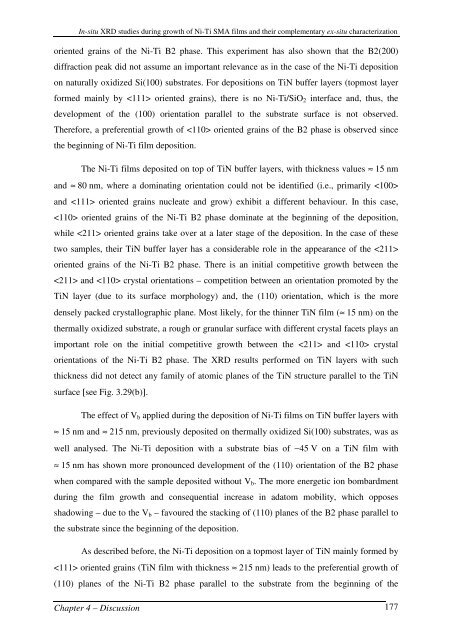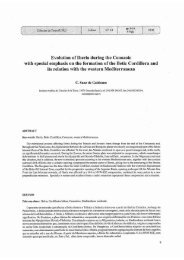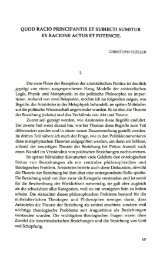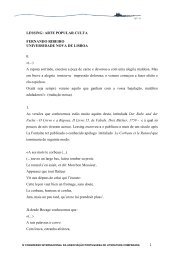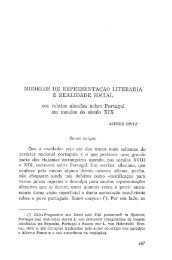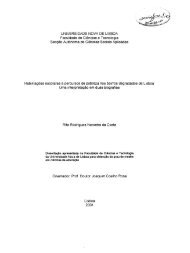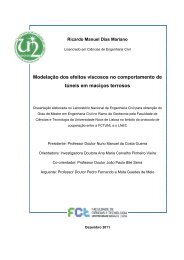PhD Thesis_RuiMSMartins.pdf - RUN UNL
PhD Thesis_RuiMSMartins.pdf - RUN UNL
PhD Thesis_RuiMSMartins.pdf - RUN UNL
You also want an ePaper? Increase the reach of your titles
YUMPU automatically turns print PDFs into web optimized ePapers that Google loves.
In-situ XRD studies during growth of Ni-Ti SMA films and their complementary ex-situ characterization<br />
oriented grains of the Ni-Ti B2 phase. This experiment has also shown that the B2(200)<br />
diffraction peak did not assume an important relevance as in the case of the Ni-Ti deposition<br />
on naturally oxidized Si(100) substrates. For depositions on TiN buffer layers (topmost layer<br />
formed mainly by oriented grains), there is no Ni-Ti/SiO 2 interface and, thus, the<br />
development of the (100) orientation parallel to the substrate surface is not observed.<br />
Therefore, a preferential growth of oriented grains of the B2 phase is observed since<br />
the beginning of Ni-Ti film deposition.<br />
The Ni-Ti films deposited on top of TiN buffer layers, with thickness values ≈ 15 nm<br />
and ≈ 80 nm, where a dominating orientation could not be identified (i.e., primarily <br />
and oriented grains nucleate and grow) exhibit a different behaviour. In this case,<br />
oriented grains of the Ni-Ti B2 phase dominate at the beginning of the deposition,<br />
while oriented grains take over at a later stage of the deposition. In the case of these<br />
two samples, their TiN buffer layer has a considerable role in the appearance of the <br />
oriented grains of the Ni-Ti B2 phase. There is an initial competitive growth between the<br />
and crystal orientations – competition between an orientation promoted by the<br />
TiN layer (due to its surface morphology) and, the (110) orientation, which is the more<br />
densely packed crystallographic plane. Most likely, for the thinner TiN film (≈ 15 nm) on the<br />
thermally oxidized substrate, a rough or granular surface with different crystal facets plays an<br />
important role on the initial competitive growth between the and crystal<br />
orientations of the Ni-Ti B2 phase. The XRD results performed on TiN layers with such<br />
thickness did not detect any family of atomic planes of the TiN structure parallel to the TiN<br />
surface [see Fig. 3.29(b)].<br />
The effect of V b applied during the deposition of Ni-Ti films on TiN buffer layers with<br />
≈ 15 nm and ≈ 215 nm, previously deposited on thermally oxidized Si(100) substrates, was as<br />
well analysed. The Ni-Ti deposition with a substrate bias of −45 V on a TiN film with<br />
≈ 15 nm has shown more pronounced development of the (110) orientation of the B2 phase<br />
when compared with the sample deposited without V b . The more energetic ion bombardment<br />
during the film growth and consequential increase in adatom mobility, which opposes<br />
shadowing – due to the V b – favoured the stacking of (110) planes of the B2 phase parallel to<br />
the substrate since the beginning of the deposition.<br />
As described before, the Ni-Ti deposition on a topmost layer of TiN mainly formed by<br />
oriented grains (TiN film with thickness ≈ 215 nm) leads to the preferential growth of<br />
(110) planes of the Ni-Ti B2 phase parallel to the substrate from the beginning of the<br />
Chapter 4 – Discussion 177


